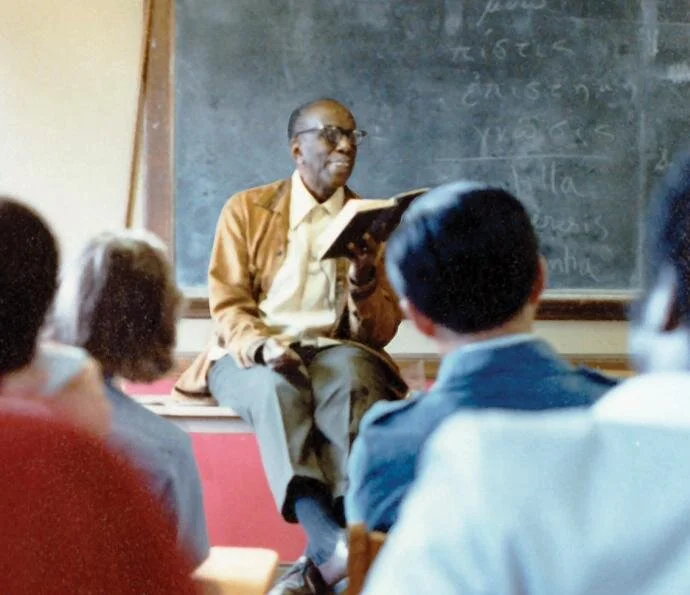Friday Reflection Part I: On Columba, Abbot of Iona: Monk, Teacher, CEO and Pilgrim
I. As coronavirus restrictions have lessened and we’re beginning to feel the worst may now be behind us, a time of reassessment and wonderment has begun to take shape. And so, right now, the deep questions keep bubbling up: What has been going on for the last four-five months? What really has happened and what is still to happen? The loss of life because of COVID-19 is global and local, diverse in age, gender, race, ethnicity, even though we have to recognize the COVID-19 deaths are not completely diverse at all… The “what if” became “why” and the “why” became “how” and “when.” Perhaps the only emotion more comprehensive than grief has been loss. Still, in the midst of such loss have come extraordinary gatherings of solidarity, community and collective action. And what we have also seen have been explosions of violence. Deep, very old, and enduring causes of people’s hurt and anger have been given new and very painful exposure and have often been greeted with the worst of “law and order.”
Click here for the biography of Columba from A Great Cloud of Witnesses
II. Into this new reality, I believe the Holy Spirit is at work again because the Church asked us to celebrate on Tuesday, June 9, the life and ministry of Columba, Abbot of Iona (521-597), thinking perhaps that Columba has something to teach us. The bio from A Great Cloud of Witnesses is found here, and a quick reading will confirm that we can learn a few things from this singular monk.
III. It is unusual, perhaps, that something so historically remote as Columba’s ministry and witness can be so timely. Christian monasticism is the oldest form of Christian religious life that still exists. The roots of both Eastern and Western monasticism were in the ascetical movements of the early Church and, thanks primarily to the 4th Century Desert Fathers and to the leadership of Antony and Pachomius, the two forms of monastic life, the eremitical (hermit life) and the coenobitical (common life) continue to this day. And it is difficult to imagine a monastery more well known and popular than Iona (Iona Abbey, 563), except perhaps Mont-Saint-Michel (709) in Lower Normandy (France). However, in terms of the history and development of both Eastern and Western monasticism, the influence of Iona and its founder, Columba, may be more significant and lasting.
IV. After almost 15 centuries of study by academics and scholars, the consensus is that the model Columba and his 12 companions sought to follow when they established Iona Abbey was not a traditional one, because at that time there was no standard model—and no real effort to establish one—for monastic communities. The Rule of Benedict (516) had not yet reached Ireland and Scotland, but there were well known “Rules,” all of which came out of Eastern Monasticism and the Desert Fathers, for example, the Regula Magistri, and the writings of John Cassian and Jerome. The models for Western Monasticism were few. Columba and his 12 companions, therefore, created a model that was intended to be a better strategy for navigating political and religious landscapes. The “model” Columba constructed was an evangelical one, grounded in teaching. But the evangelism Columba had in mind was the important work of establishing new monasteries. Through these “Schools in the Lord’s Service,” and the ministry of the monks themselves, would come the missionary work of bringing individual souls into the Christian faith, for example the conversion of the Picts. For Columba and his fellow monks, evangelization was teaching, and the speaking and listening that came with it. Healing became part of Columba’s ever-expanding ministry and the healing that comes with teaching became part of his commitment to the preparation of his monks for their own work, the work of evangelism.
V. The second reading for the service to be celebrated on the commemoration of Columba is Isaiah 61: 1-3. and the first two lines of the first verse are at the core of Columba’s witness: The spirit of the Lord is upon me, because the Lord has anointed me to bring good news… When we consider what Columba accomplished in his lifetime (he was 75 when he died), we can understand more about his sense of his own calling and mission. As I’ve wanted to emphasize, Columba was a teacher in everything he did. Iona Abbey was a center of learning, as were all the other monasteries he founded after Iona. Columba’s model was a kind of community center, a place of all kinds of teaching and learning. His monasteries were schools and the students, while formally taught and trained, were not expected to become monks. Columba, as Abbot, was seen as the figure of authority and leadership, both in the monastery as well as in the larger community of which he very much felt the monastery was a part. By Columba’s last years, the Abbot of the monastery was the most significant figure in the community—indeed he was understood as the Master Teacher, a practice that became more widespread in the late Middle Ages. Columba was his own kind of CEO, school head, Master Teacher, spiritual director, and primary Liturgical presider in common worship. In a number of ways, Columba anticipated many of the features of the Rule of Benedict which was written and then circulated toward the middle of the 6th century. Irish and Scottish monastic communities, however, did not follow Benedict’s Rule until the late 7th century when most monastic communities in the West had begun to do so. In Columba’s monasteries, the abbot was meant to be an unlimited and inexhaustible source of creativity and imagination as well as a capable and successful administrator. What is often referred to as “Celtic Christianity” is part of this “creativity and imagination,” and can be seen as a way to ensure that Columba’s monasteries were open to all kinds of people with different callings and different goals.
VI. What ought not be overlooked is that Columba was a successful diplomat and politician and this, no doubt, made it easier to create new monasteries, and to establish elements of daily life in the monastery where a monk with a contemplative calling could find a place for expression at the same time that another monk could find fulfillment in an active life within and outside of the community. These were also places in which married and unmarried lay people could live, study, learn and pray. More than anything, Columba wanted his monasteries, beginning with Iona, to be centers of learning, prayer, spirituality and service.
VII. Like many of the saints and holy people who have been honored with recognition in A Great Cloud of Witnesses, Columba would seem to be another one of the “modern” saints, though in his case he was well ahead of his time. For me, Columba is a teacher, learner, healer, executive, pastor and preacher, all elements of his calling and, with his fervor and zeal, are essential qualities of his modern sainthood. In the end, Columba was a “Big Picture” fellow and the church and Western Monasticism have been enriched immeasurably by his view of the world as a Christian community, and by his life and work. As evangelist, abbot, politician, and everything else he was, Columba was an evangelizing monk and so he was in the world more than he was out of it.
VIII. As we have lived with the coronavirus over these last many months, we often have been “out of the world,” and might experience this time as unwelcomed and forced solitude. Columba’s words at his death are well worth pondering for their perspective and wisdom: “This day is called in the sacred Scriptures a day of rest, for truly to me it will be such, for it is the last of my life and I shall enter into rest after the fatigues of my labors.” As he might remind us today, solitude has its virtues, even forced and unwelcomed, and was something Columba wanted much more of. But there was that calling…
O God, by the witness of your blessed servant Columba, you caused the light of the Gospel to shine in Scotland: Grant, we pray, that having his life and labors in remembrance, we may show our thankfulness to you by following the example of his zeal and patience, through Jesus Christ our Lord…
—Collect of the Commemoration of Columba, Abbot of Iona
Amen.
—Father Peter Kountz










